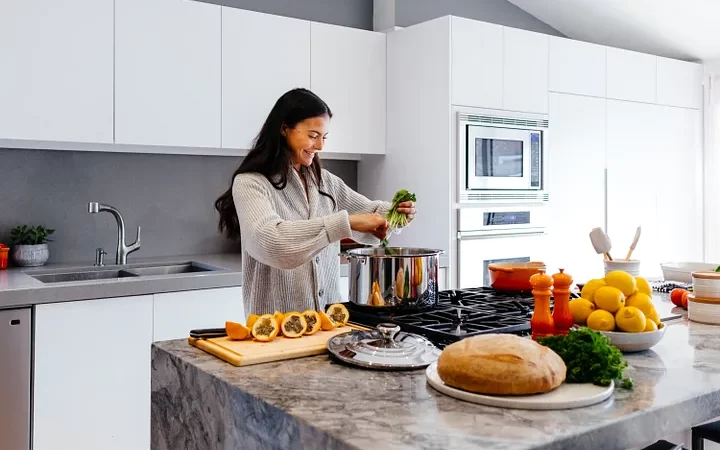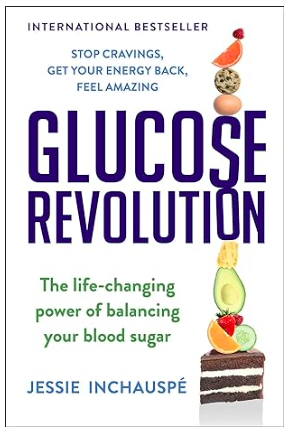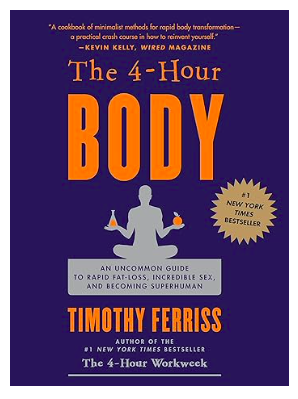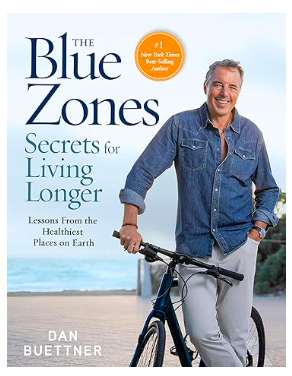Disclaimer: To make this site free for our readers, we earn money from advertising, affiliate sales and sponsorships. Please see our disclosure page for more info on how this works.
*****
I find healthy eating fairly easy and I’ve never been overweight, so why am I constantly trying to eat healthier? The main reason is that I’m lazy, and optimising nutrition is one of the simplest tweaks any of us can make to improve overall health.
There are a number of reasons why most experts consider that nutrition is more important than exercise when it comes to healthy weight loss and weight management. And that’s good news for me, because I find it much easier to eat healthier than I find it to work out harder. Here’s are the (rough) guidelines I’ll be focusing on as I try to eat even healthier than I already do.
- Eat a good balance of protein, complex carbs and healthy fats
- Fill your plate with as many different colours as possible
- Minimise glucose spikes by eating fibre first and enjoying gentle physical activity after meals
- Eat real food and moderate portions
- Consume plenty of plants
- Have a 12 hour ‘fasting’ window
- Get 30 grams of protein within 30 minutes of waking (preferably followed by 30 minutes of exercise)
- Eat when you’re hungry, stop when you’re full
Let’s break that down.
How I eat:
The main focus here will be:
- Macronutrients and eating the rainbow
- Glucose and how to regulate it
- Real food, moderate portions, and a plant-heavy bias
Macronutrients and eating the rainbow
I already know that keeping things simple is key for me when it comes to nutrition. I won’t be over-analysing, fussing about micronutrients, or counting calories (never have, never will). I will be making sure I get a good balance of macronutrients: in the form of:
- Protein — Eggs, lean meat, oily fish, nuts and seeds, beans and pulses, green leafy veg, and Greek yogurt
- (Complex) carbs — Veggies, oats, whole grains, pulses, barley and quinoa
- (Healthy) fats — Oily fish, avocado, olive oil and nuts
I’ll also be “eating the rainbow”. It’s such a simple way to think about what you put on your plate. More colours = more nutrition. So I’ll be loading up on a rainbow of food, including:
- Red (and pink) — Tomatoes, red peppers, strawberries, raspberries, watermelon, grapefruit
- Orange — Oranges, tangerines, peaches, carrots, sweet potatoes, pumpkins, squash, cantaloup melon
- Yellow — Bananas, pineapple, yellow peppers, corn
- Green — Broccoli, spinach, kale, arugula, green peppers, peas, asparagus, avocado, green grapes, dark green salad leaves
- Blue, indigo and violet– eggplant, blueberries, plums, dark grapes, and ‘red’ cabbage and onions
Aiming for colour is so much easier (and aesthetically pleasing) than fussing about micro-nutrients.
Glucose and how to regulate it
I recently stumbled across an interview with Jessie Inchauspé, also known as the Glucose Goddess, and author of The Glucose Revolution. Like many people I don’t think much about glucose, but I recognise a bad glucose spike when it hits me.
Inchauspé points out that the simplest things, like eating fibre-rich veggies before the rest of your meal, and taking gentle exercise soon after eating (we’re talking a stroll around the block, not a full work-out) can help minimise glucose spikes.
Again, the advice is so simple, but, according to her glucose monitor, mostly very effective. I’ll be trying it out and seeing how it goes.
Real food, moderate portions, and a plant-heavy bias
I’ll also be following the advice I’ve talked about before, dished out by Michael Pollan:
Eat food, not too much, mostly plants
The first two are simple. In a world full of food-like products, choose real food, and don’t overeat. The third can be controversial. Every time I mention it, someone tells me how important animal products are for proper nutrition. I’m not going to argue about it, especially as I’m not vegan, or even vegetarian. But plants make up a very substantial part of what I put on my plate and in my body, and that works for me.
To sum up, I’ll be aiming for:
- A good balance of protein, complex carbs and healthy fats
- A rainbow coloured plate, whenever possible
- Minimal glucose spikes by tweaking my food choices and physical activity
- Real food and moderate portions
- Plant-rich meals, most of the time
When I eat:
When we eat matters too. I’ll be experimenting with:
- 12:12 eating
- 30 grams of protein within 30 minutes of waking up
This is how that will look.
12:12 Eating
I’ve looked into intermittent fasting. I understand the science behind it, and I have friends who have controlled or reversed serious health issues using it. But it’s not for me. At least not in its more popular forms. My body doesn’t like to go more than 12 hours without sustenance. Frankly it makes me grumpy, and I don’t like me when I’m grumpy.
So I’ll be looking at adopting a 12:12 plan, as recommended by Colin Rose in Delay Ageing: Healthy to 100. A 12-hour window when I eat. A 12-hour window when I don’t. Some people make their food-free window 6 pm to 6 am. Others make it midnight to midday. A lot will depend on your daily routines, work shifts and what feels right for you. I’ll be aiming for 7pm to 7am because for me, it just works.
30 grams of protein within 30 minutes of waking up
This is a new one for me and I was first exposed to it by The Sculpted Vegan, although I’ve since learned it’s best known as a concept from Tim Ferris’s 4-Hour Body book.
Ferris refers to it as the 30/30/30 concept and advocates topping off your 30 grams of protein within 30 minutes of waking with 30 minutes of exercise. I’m prepared to give it a try. This is why my 12:12 window is 7–7 (given that 6.30 is a normal wake-up time for me).
Because I’m not really into such things, I’ve had to look up what 30 grams of protein looks like. Apparently it’s something like this:
- Five eggs (not really appealing for me, even though I like eggs)
- One cup of Greek yogurt with berries and nut butter (much more doable)
- A smoothie made with fresh fruit, seeds and a scoop of protein powder (totally doable)
As the gym bunnies know, a single scoop of protein powder from the right brand can deliver that 30 grams of protein in one easy hit, but I’m not sure that’s the best way to get your protein. I’ll be experimenting to see what works for me, and if it actually seems to have any impact over time.
The attraction of this one is that it seems a really easy experiment to try, once I’ve stocked up on Greek yogurt and protein powder (and probably not eggs — or at least not that many).
Why I Eat:
Lastly I’ll be eating more mindfully, which means looking at why I eat. The best reason to eat is because you’re hungry. Not because you’re bored, sad, or under social pressure. Some of us have got to the stage that we eat either routinely or constantly and never really feel hungry. Some people actually see hunger as an incredibly negative thing and even something to be scared of.
In a world where many of us don’t actually ever have to feel the discomfort of hunger it has somehow become an unfamiliar feeling and — for some — a sign that they are not eating enough, rather than a natural sign that it is probably time to eat again fairly soon. As a general guideline, I’ll be aiming to do something that seems blindingly obvious but is rarer than you’d think:
Eat when I’m hungry, and stop when I’m full.
Most of us eat for emotional reasons at times, and many of us sometimes attend social events that involve eating at less-than-optimal times for us, but as a general rule, when we have the option, it can make sense to listen to what our bodies are telling us. I’m going to listen to mine and (mostly) eat when I’m hungry.
And the stop-when-you’re-full piece? Full doesn’t have to be an absolute term. I’ve recently read the Blue Zones book (and watched the docuseries of the same name). One of the many concepts I’ve taken from it is Hara Hatchi Bu, the Confucian-inspired Japanese phrase that implies you should stop eating when you’re 80% full.
There’s no magic formula or measuring technique that will tell you when you’re 80% full, but I’ve been trying this one out and I promise you, over time you’ll work out when it is, and feel so much better for it. You’re 80% full when you’re satisfied but not stuffed. No longer hungry but not feeling sick and bloated from over eating. Fully nourished, but not nursing a ‘food baby’ in your swollen belly as you get up from the table.
Too long, didn’t read? Here’s the summary again
- Eat a good balance of protein, complex carbs and healthy fats
- Fill your plate with as many different colours as possible
- Minimise glucose spikes by eating fibre first and enjoying gentle physical activity after meals
- Eat real food and moderate portions
- Consume plenty of plants
- Have a 12 hour ‘fasting’ window
- Get 30 grams of protein within 30 minutes of waking (preferably followed by 30 minutes of exercise)
- Eat when you’re hungry, stop when you’re full
Overhauling the way you eat isn’t easy, but I think I’ve got it down to eight (fairly) simple ideas there, so I’m feeling hopeful. Want to try this with me? Feel free to join in. Let me know how it goes.
Originally published in Illumination. Re-published here with permission.
Featured image by Jason Briscoe on Unsplash.
Want to improve your life, week by week? Get our free guide, 20 Things To Do Every Week.




